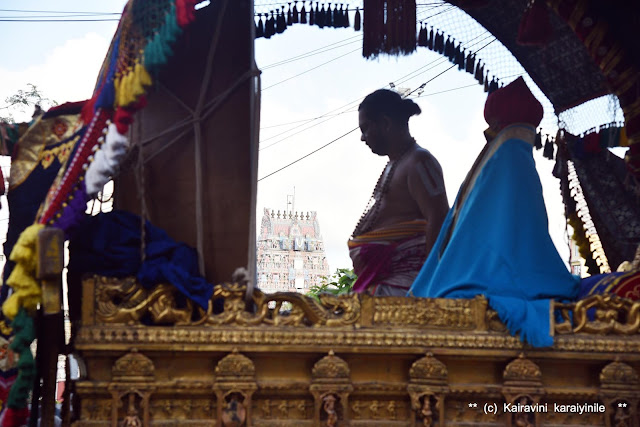"ஆளும் பல்லக்கு " - 'மட்டையடி' எனப்படும் ப்ரணய கலஹம்'
Do you know what is a finial and what is litter ? – litter reference here is not to small pieces of rubbish that have been left
lying on the ground in public places: or to baby animals !
திருக்கோவில்களில்
எம்பெருமான்களை எடுத்து செல்லும் வாஹனம் பல்லக்கு. திருவல்லிக்கேணியில் தினமும் காலையில் செல்வர் பல்லக்கில்
எழுந்தருளி பலி சாதித்து அருள்வார். தங்க பல்லக்கு, முத்து பல்லக்கு, புஷ்ப பல்லக்கு
என பல்வேறு வகைகள் உள்ளன. திரு அழகிய சிங்கர்
சிறப்பு ப்ரஹ்மோத்சவத்தின் ஒன்பதாம் நாளை காலையான இன்று ஆள் மேல் பல்லக்கு !!
பல்லக்கு
அல்லது சிவிகை என்பது மனிதர்கள் சுமந்து செல்லும்
ஒரு வகை வாகனம். பல்லக்குகளில் பல வகைகள் உள்ளன. வரலாற்றில் பல நாடுகளில் பல வகைப்
பல்லக்குகளைப் பயன்படுத்தியுள்ளார்கள். பல்லக்குகளில் ஒருவரோ ஒரு சிலரோ அமர்ந்து கொண்டோ
சாய்ந்து கொண்டோ பயணிக்க முடியும். பயணிகள் பெட்டிக்கு (இருக்கை) முன்னும் பின்னும்
உள்ள நீண்ட கம்பங்களை தோள்களிலும் கைகளிலும் சுமந்து பணியாளார்கள் நடக்க, பல்லக்கு
நகருகின்றது. உலகம் எந்திரமயமான பின்னர் சிவிகைகளைப் பயன்படுத்துவது பெரும்பாலும் நின்று
விட்டது.
Day nine morning is
purappadu in pallakku – palanquin with top closed and sides open .. .. the The
tradition of wheel-less carriages for travelling is very old in India. The earliest literary reference of the use of
palanquin, popularly known as ‘Palki’, can be traced back to Ramayana (approx
250 BC).
The litter is a class of
wheelless vehicles, a type of human-powered transport, for the transport of
persons. Smaller litters may take the form of open chairs or beds carried by
two or more carriers, some being enclosed for protection from the elements.
Larger litters, for example those of the Chinese emperors, may resemble small
rooms upon a platform borne upon the shoulders of a dozen or more people. To
most efficiently carry a litter, porters either place the carrying poles
directly upon their shoulders or use a yoke to transfer the load from the carrying
poles to the shoulders. The word is
derived from the Sanskrit palyanka, meaning bed or couch and later on British called it ‘Palan Queen’.
The Malay and Javanese form is palangki, in Hindi and Bengali, palki. The
Portuguese apparently added a nasal termination to these to make palanquim.
English adopted it from Portuguese as "palanquin". Palanquins vary in size and grandeur. The
smallest and simplest, a cot or frame suspended by the four corners from a
bamboo pole and borne by two bearers, is called a doli. In some exquisitely made ones, interiors are
furnished with bedding and pillows. Ornamentation reflects the social status of
the traveller. The most ornate palanquins have lacquer paintwork and cast
bronze finials at the ends of the poles. Designs include foliage, animals, and
geometric patterns.
Ibn Batutta describes them
as being "carried by eight men in two lots of four, who rest and carry in
turn. In the town there are always a number of these men standing in the
bazaars and at the gate of King and
noble men for hire." Those for
"women were covered with silk curtains."
Day 9 of Brahmothsavam would
be hectic ~ morning there is purappadu in ‘Aaal mael pallakku’ –
Porvai kalaithal vaibhavam – pranaya kalagam (mattaiyadi) – thirumanjana kudam,
theerthavari – purappadu – evening Pathi ulavuthal – Kannadi pallakku –
thirumbukal – dwaja avarohanam, and more.
For Sri Azhagiya singar ‘
mattaiyadi’ – the ‘pranaya kalaham’ arising out of the celestial bonds between
‘Thayar and Perumal’ with Ubaya Nachimar and Perumal engrossed in
wordy duel occurs at the western gate ie., the rear entrance to the temple at
Thulasingaperumal koil street. .. .. Perumal’s entry is denied with
thayar slamming the doors and later after the intervention of Swami Nammalwar,
Perumal and Ubhayanachimar play exchanging the flower ball – throws and catches
being taken by the battars.
இன்று காலை புறப்பாடு "ஆளும் பல்லக்கு " - இந்த பல்லக்கு நான்கு ஆட்கள் தங்கள் தோள்கள்
மீது பல்லக்கை சுமப்பது
போன்றே அமைந்து இருப்பதால் "ஆள் மேல்
பல்லக்கு:. இந்த பல்லக்கில் பெருமாள் நிறைய
போர்வைகளை போற்றிக்கொண்டு எழுந்து அருள்கிறார். திருமங்கை மன்னனை ஆட்கொண்ட
படலத்தில், பெருமாள் ஒரு
கணையாழியை [மோதிரத்தை] தொலைப்பதாகவும், அதிகாலை பெருமாள் நாச்சிமாருக்கு கூட தெரியாமல் தனது மோதிரத்தை தேடி போர்வையுடன் வந்து,
முன் தினம் கலியன் வைபவம் நடந்த அதே இடத்தில் நகையை தேடும் வைபவம் "போர்வை களைதல்" என கொண்டாடப்படுகிறது.
ப்ரஹ்மோத்சவத்திலே 9ம்
நாள் ஆள் மேல் பல்லக்கு - பெருமாள் போர்வை களைதல் வைபவம் - இந்த வருடம் அசம்பாவிதம்
காரணமாக பெரிய மாட வீதி புறப்பட்டு இல்லை. குளக்கரை புறப்பாட்டிற்கு பிறகு போர்வை களைதல்
வைபவம் தென்னண்டை மாட வீதியில் கோவில் கோபுரம் / அத்தங்கி திருமாளிகை முன்பே நடந்தேறியது. பின்னர் தெற்கு மாட வீதி புறப்பாடு கண்டருளி மேற்கு கோபுர வாசலில் மட்டையடி வைபவமும், பிறகு
பூப்பந்து விளையாடுதலும் விமர்சையாக நடைபெற்றன.
A finial or
hip-knob is an element marking the top or end of some object, often formed to
be a decorative feature. In architecture, it is a small decorative device,
employed to emphasize the apex of a dome, spire, tower, roof, or gable or any
of various distinctive ornaments at the top, end, or corner of a building or
structure. One could see the ornate lion hued finial on Ael mel pallakku,
though shape has been lost over the years !! Here
are some photos of day 9 of Sri Azhagiya Singar special brahmothsavam ‘mattayadi’
vaibhavam on 10.3.2021.
Mamandur Veeravalli Srinivasan Sampathkumar
10.03.2021




















No comments:
Post a Comment